Cinereous Vulture Profile
Deep in the rugged mountains of Europe and Asia, a giant bird of prey roams the skies. With a wingspan of almost 3 meters, it soars above the craggy peaks in search of its next meal.
But this is no hunter. It is the cinereous vulture, a scavenger shunned by legend and pushed towards population decline.
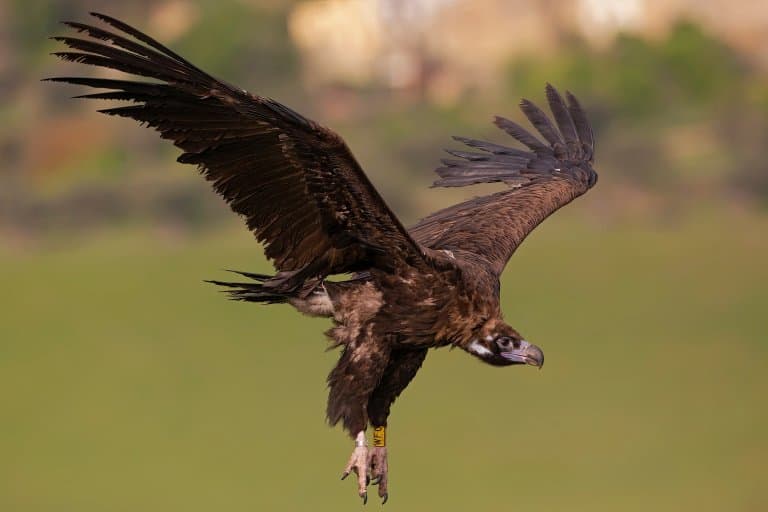
Cinereous Vulture Facts Overview
| Habitat: | Forest, shrubland, grassland, alpine steppe |
| Location: | Predominantly China and Mongolia, but widespread through Europe, Northern Asia, and the Middle East |
| Lifespan: | Up to 40 years |
| Size: | Up to 3 m (10 ft) wingspan |
| Weight: | Up to 13 kg |
| Color: | Dark brown |
| Diet: | Carrion |
| Predators: | None |
| Top Speed: | 50 – 60 kph (31 – 37 mph) |
| No. of Species: |
1 |
| Conservation Status: |
Near Threatened |
The Cinereous vulture is one of the largest birds in the sky and is known as the black vulture, monk vulture and Eurasian black vulture. It’s a heavy long-distance gliding raptor that conservationists are now fighting to protect in many parts of Europe.
This is a species that reaches all the way from Spain, across Europe, the Middle East and Asia. They prefer remote mountainous areas, where they can nest and forage for food.
Like all vultures, they feed on carrion, and depending on their location will eat large mammals, to reptiles and fish.
There’s so much this bird can teach us about ecology, conservation and disease protection, and their incredible immunity to pathogens makes them well worth studying.
Sadly, they breed very slowly and need our help to get their populations stable again.
Interesting Cinereous Vulture Facts
1. It’s the largest vulture in the world
This giant raptor is the largest old world vulture, and is one of the largest flying birds around, with a wingspan of over 3m (10.5 ft. Only the wandering albatross has a larger wingspan.
Female cinereous vultures are larger than their male counterparts, and can weigh as much as 14 kg (31 lb), which also makes it one of the heaviest birds in the sky.
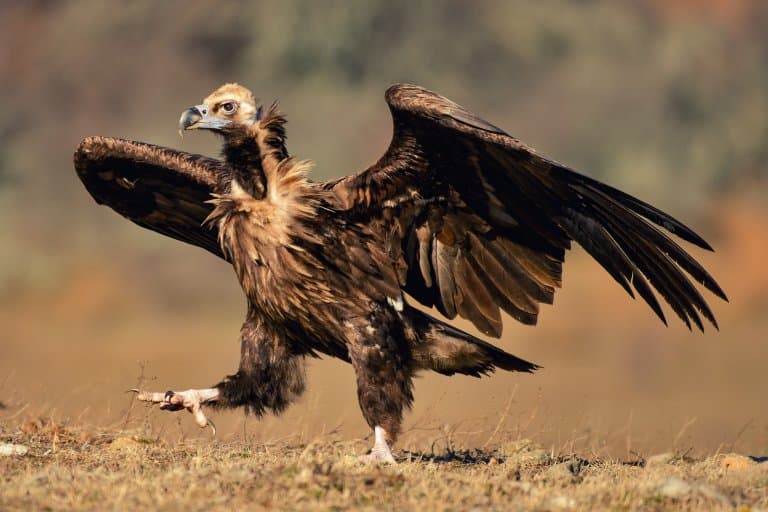
2. They are high flyers
Cinereous vultures are able to fly to incredible altitudes due to specialized haemoglobin alphaD subunit in their blood, which allows it to absorb oxygen efficiently even at great heights.
They have even been observed at an elevation of 23,000 ft (7,000 m) on Mount Everest.
3. They’re making a comeback
This is literally a legendary bird, thought to be referenced in mythological texts like the bible and Qur’an.
Still, it’s been persecuted by livestock breeders either directly or indirectly as a way of reducing threats to their domesticated animals. As a result, many European populations went extinct.
Reintroduction programs are well underway and countries like France and Bulgaria are monitoring populations closely. 1
4. Cinereous vultures can congregate in large groups
While mainly solitary like most vultures, the cinereous vulture can be found in pairs more often than other New World Vultures.
Large groups of up to 30 vultures do on occassion congregate around larger carcasses, along with other species.

5. Bird politics
Being large scavengers, these birds don’t worry so much about predation. However, they need to figure out how to distribute their food sources between them.
Vultures can’t choose when they eat; they have to make do with whatever drops dead nearby, whenever that happens. This leads to heightened levels of competition among members of their guild, both in their own species and their neighbour species.
Researchers are trying to crack the code of bird dominance hierarchies, especially in groups of vultures, to help learn ways to protect them.
Cinereus vultures in Europe scavenge alongside the Griffon vultures and the bone-eating Bearded vulture and are well-built to compete.
Cinereus vultures are larger, more aggressive, and have powerful beaks and claws which puts them at the top of the competition.
These three species compete for the same resource but have their own ways to go about it. In the case of the Cinereus vulture, they have the unique ability to fluff up their feathers and march threateningly on their competitors. 2
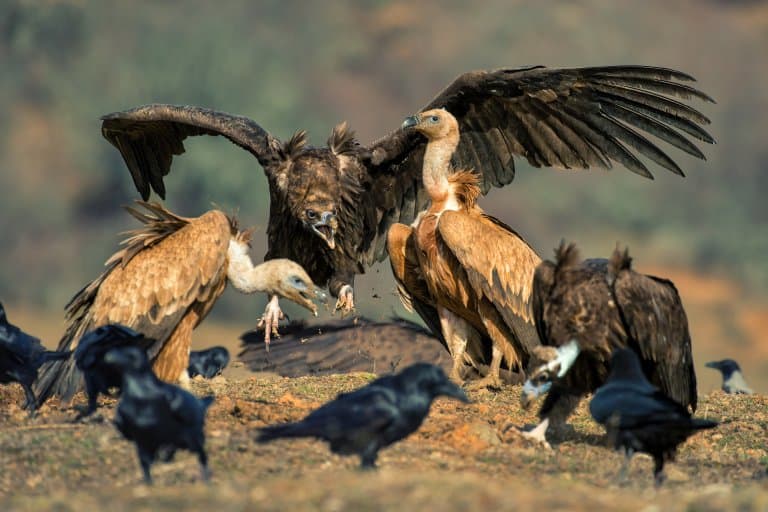
6. They have powerful stomachs
Like all carrion feeders, the Cinereous vulture has a powerful acid in its stomach. As a bird, it’s equipped with a gizzard that, in this case, is a particularly powerful, muscular chamber that grips and grinds on the decaying meat fed into it, aiding in its breakdown.
The stomach of the Cinereous vulture has a high level of enzymes for breaking down the proteins in its meaty diet, but more than this, the low pH incinerates pathogens, giving it a high resilience to bacterial infection.
7. And a spicy butthole
The pathogen-killing adaptations don’t stop at the stomach. The entire digestive tract from the microflora on the face to those in its butt are well designed to protect it from disease.
It is said to have a very acidic cloaca, which helps to protect its habitat from pathogens even after it’s eaten.
These remarkable protections have led it to become more or less immune to scary diseases such as botulism and even anthrax. 3
8. They have one of the largest bills of any bird of prey
It can measure up to 8–9 cm (3.1–3.5 in) in length, and can look even larger as they have relatively small heads.
Only their cousin the lappet-faced vulture can rival its bill size.
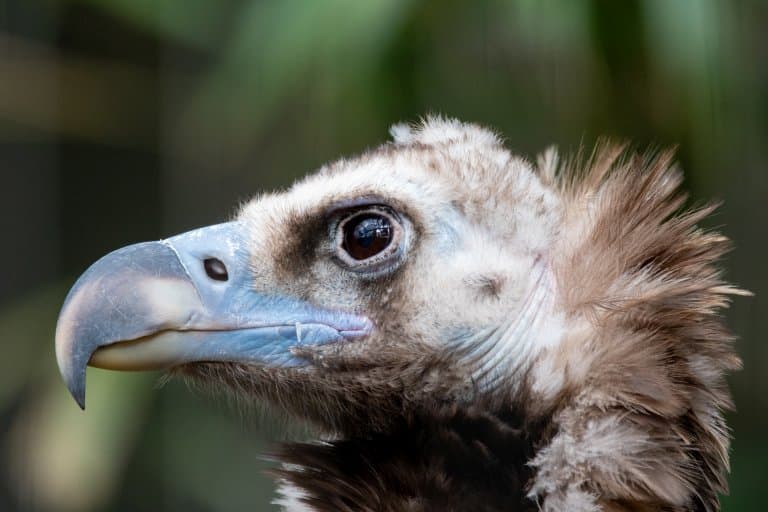
9. They have been seen hunting livestock
While generally they will feed on carrion, the cinereous vulture has occassionally been observed preying on live animals as well.
Livestock such as valves, cattle, lambs, sheep, as well as foxes, rodents and birds such as pheasants and geese can be preyed upon.
10. They are disease-cleaning
As waste-removal species, animals like the Cinerous vulture can handle hazmat that would otherwise become a public health concern.
Many animals like rats, flies, and cockroaches are known vectors of disease because of the conditions in which they live. Vultures, on the other hand, are disease-cleaning animals that tidy up corpses and dissolve these diseases in their stomach acids.
This, contrary to their reputation and appearance, makes them very clean and useful animals and helps to rid our environment of potentially devastating germs. 4
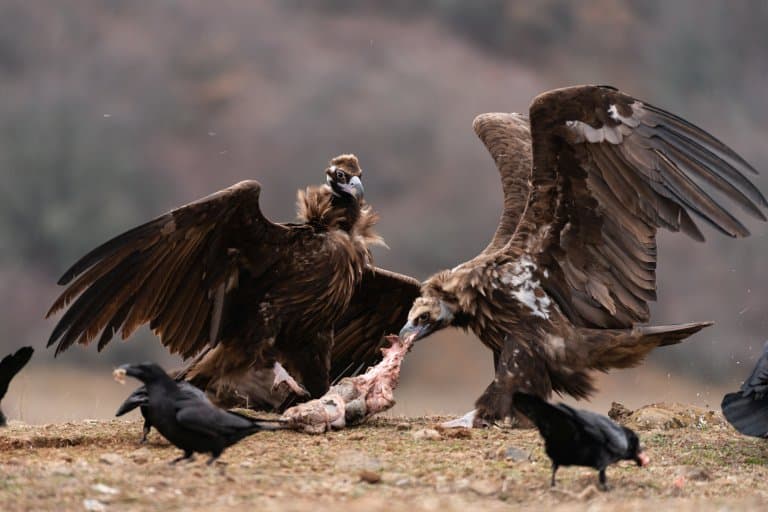
11. Yet, they are still persecuted
Conservationists understand the significance of these enormous birds to a healthy ecosystem and have been working to reintroduce them to regions in Europe where they had been driven to extinction.
Still, they have a bad reputation for killing livestock and are often victims of indiscriminate poisonings by local farmers.
Even if vultures aren’t directly targeted, farmers may leave toxins for wild predators that will eventually end up in the vulture population anyway.
In China, these vultures are directly hunted for their feathers, and in Russia, they’re illegally captured for zoo displays. 5
12. Their slow breeding makes them vulnerable
One of the reasons they need so much protection is their long breeding period.
Cinereous vultures have the longest breeding cycle of any raptor in Europe at up to 68 days, and after that, only a single egg is laid. After hatching it can be up to another 137 days before the young leaves the nest.
Other than this, the breeding requirements are still not well known, which makes conservation difficult. Education plays a big role in their protection, as farmers need to know and appreciate the value these enormous recyclers have on the local ecosystem.
Other common threats to their populations are electrocution from power lines and habitat degradation. 6
Cinereous Vulture Fact-File Summary
Scientific Classification
| Kingdom: | Animalia |
| Phylum: | Chordata |
| Class: | Aves |
| Order: | Accipitriformes |
| Family: | Accipitridae |
| Genus: | Aegypius |
| Species Name: |
Aegypius Monachus |
Fact Sources & References
- Typhaine Rousteau, Olivier Duriez, Roger Pradel, François Sarrazin, Thierry David, Sylvain Henriquet, Christian Tessier, Jean-Baptiste Mihoub (2022), “High long-term survival and asymmetric movements in a reintroduced metapopulation of Cinereous vultures“, Ecosphere.
- Rubén Moreno-Opo, Ana Trujillano, Antoni Margalida (2020), “Larger size and older age confer competitive advantage: dominance hierarchy within European vulture guild“, PMC.
- Will Dunham (2015), “One tough bird: vulture’s genes help it thrive on rotting flesh“, Reuters.
- Dan Greaney (2017), “Vultures have the pH for public health“, Record Searchlight.
- Green Balkans and FWFF (2022), “One of the recent poisoning victims in Bulgaria was a female Cinereous Vulture with an egg“, VCF.
- Jovan Andevski, Vulture Conservation Foundation (2017), “FLYWAY ACTION PLAN FOR THECONSERVATION OF THE CINEREOUS VULTURE“, CMS.
